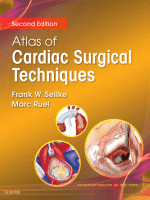Physical Address
304 North Cardinal St.
Dorchester Center, MA 02124

Step 1 Surgical Anatomy ◆ Type A dissection is defined by the presence of a septum creating two lumens within the ascending aorta. The DeBakey classification further divides the Stanford type A classification according to whether the septum is located…

Step 1 Surgical Anatomy ◆ The tricuspid valve is located between the right atrium (RA) and right ventricle and has a valve area of 4 to 6 cm. The tricuspid valve is composed of three leaflets—the anterior, posterior, and septal. The…

Step 1 Surgical Anatomy ◆ Percutaneous therapies have changed how the modern cardiothoracic surgeon approaches the treatment of valvular heart disease. Although much of this evolution has come with the advent of transcatheter aortic valve replacement, considerable obstacles inherent to…

◆ The 2014 American College of Cardiology (ACC)/American Heart Association (AHA) guidelines strongly recommend (class I) prompt surgical correction of mitral regurgitation (MR) for patients in stages D (severe symptomatic MR) and C2 (severe asymptomatic MR with left ventricular ejection…

◆ Mitral valve dysfunction is a common pathologic process. The process may involve any component of the valve or subvalvular structures, including the valve leaflets, the annulus, the papillary muscles, the chordae tendineae, and the left ventricular wall. ◆ The…

Step 1 Anatomy ◆ The mitral valve is a complex structure comprised of an anterior and posterior leaflet that is connected to the left ventricle via attachments to papillary muscles through the chordae tendineae. ◆ It is anchored to the…

Introduction ◆ Degenerative mitral valve disease, also called mitral valve prolapse or floppy mitral valve syndrome , is caused by myxomatous degeneration of the mitral valve tissue, whereby elastin and collagen bundles are disrupted, and proteoglycan deposition in the spongiosa…

◆ The Ross procedure replaces the diseased aortic valve with a viable pulmonary autograft and uses an appropriate conduit (e.g., a cryopreserved pulmonary homograft) to reconstruct the right ventricular outflow tract (RVOT). ◆ As initially described, the autograft was placed…

◆ Transcatheter aortic valve replacement (TAVR) is a relatively new technique that has been clinically applied mostly in higher risk older patients in the past 10 years. Major differences in comparison to conventional aortic valve replacement (AVR) are as follows:…

Step 1 Pathogenesis, Pathology, and Microbiology of Left-Sided Infective Endocarditis ◆ Infective endocarditis (IE) is the most severe and devastating complication of heart valve disease, whether it is native valve endocarditis (NVE), prosthetic valve endocarditis (PVE), or infection on another…